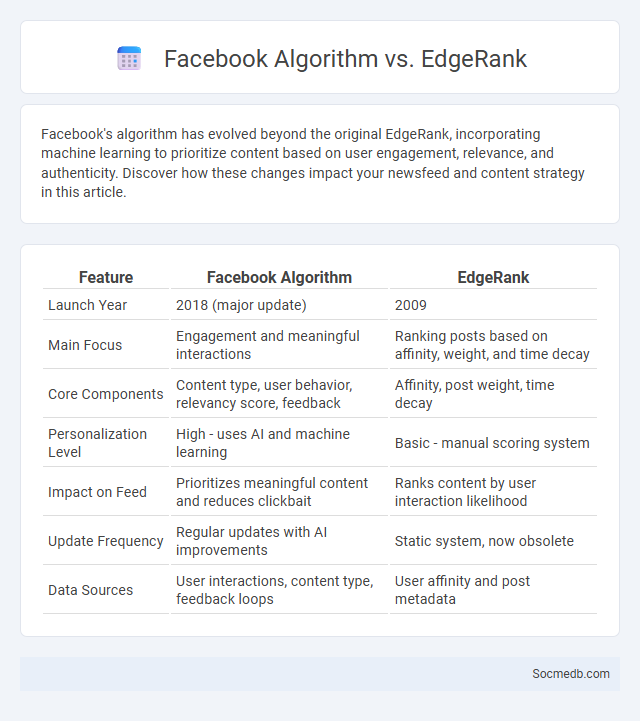
Photo illustration: Facebook Algorithm vs EdgeRank
Facebook's algorithm has evolved beyond the original EdgeRank, incorporating machine learning to prioritize content based on user engagement, relevance, and authenticity. Discover how these changes impact your newsfeed and content strategy in this article.
Table of Comparison
| Feature | Facebook Algorithm | EdgeRank |
|---|---|---|
| Launch Year | 2018 (major update) | 2009 |
| Main Focus | Engagement and meaningful interactions | Ranking posts based on affinity, weight, and time decay |
| Core Components | Content type, user behavior, relevancy score, feedback | Affinity, post weight, time decay |
| Personalization Level | High - uses AI and machine learning | Basic - manual scoring system |
| Impact on Feed | Prioritizes meaningful content and reduces clickbait | Ranks content by user interaction likelihood |
| Update Frequency | Regular updates with AI improvements | Static system, now obsolete |
| Data Sources | User interactions, content type, feedback loops | User affinity and post metadata |
Understanding the Facebook Algorithm
The Facebook algorithm prioritizes content by analyzing user interactions such as likes, comments, shares, and time spent on posts to deliver personalized newsfeeds. It leverages machine learning to predict user preferences and promote meaningful engagement while filtering out low-quality or irrelevant content. Understanding factors like post type, user behavior, and timeliness helps optimize visibility and reach on the platform.
What Was EdgeRank?
EdgeRank was Facebook's original algorithm used to determine the relevance and visibility of posts in users' news feeds. It evaluated content based on affinity between users, the weight of the interaction (such as likes, comments, and shares), and the recency of the post to prioritize engaging and timely updates. Understanding EdgeRank is crucial for optimizing social media strategies and boosting organic reach on Facebook.
Evolution of Facebook's Algorithm Over Time
Facebook's algorithm has evolved significantly since its inception, shifting from a simple chronological feed to a complex system prioritizing meaningful interactions and personalized content. Machine learning and AI now drive Facebook's News Feed, analyzing user behavior, preferences, and engagement patterns to optimize content relevance. Recent updates emphasize video content, local news, and community engagement, reflecting Facebook's goal to enhance user experience and foster authentic connections.
EdgeRank vs. Modern Facebook Algorithm
EdgeRank, once Facebook's primary algorithm, relied on affinity, weight, and time decay to prioritize content in users' News Feeds. The modern Facebook algorithm incorporates machine learning and artificial intelligence, analyzing user behavior, content type, and engagement patterns to deliver personalized and relevant posts. This evolution emphasizes meaningful interactions and predicts what content users find most valuable, moving beyond the simplistic EdgeRank formula.
Key Factors Influencing Facebook Algorithms
Facebook algorithms prioritize content based on user engagement metrics such as likes, comments, shares, and viewing duration, which significantly impact the visibility of posts. The relevance score, determined by algorithmic predictions of user interest, boosts content that aligns closely with individual preferences and past interactions. Timeliness and content type also play critical roles, with newer posts and varied media formats like videos or live streams receiving preferential treatment in users' newsfeeds.
How User Engagement Impacts Algorithm Performance
User engagement metrics such as likes, comments, shares, and time spent on content directly influence social media algorithm performance by signaling content relevance and quality to the platform. Higher user interaction rates boost content visibility through personalized feeds, increasing organic reach and user retention. Algorithms leverage these engagement patterns to optimize content distribution, enhancing user experience and platform growth.
Content Ranking: EdgeRank Rules vs. Current Algorithm
Content ranking on social media platforms has evolved significantly from the early EdgeRank rules, which prioritized factors like affinity, weight, and time decay to determine what users saw. Today's algorithms incorporate advanced machine learning models that analyze user behavior, engagement patterns, and personalized interests to deliver more relevant and timely content. Understanding these updated ranking systems helps Your content perform better by aligning with how platforms now evaluate interactions and prioritize posts.
Advantages and Limitations of EdgeRank
EdgeRank, Facebook's algorithm, optimizes user engagement by prioritizing content with high affinity, weight, and recency, enhancing relevant posts' visibility in news feeds. Its advantages include personalized content delivery that increases user interaction and helps businesses target specific audiences effectively. Limitations involve potential content echo chambers, reduced diversity in user feeds, and challenges for new or less active users in gaining organic reach.
Facebook Algorithm Transparency and User Experience
Facebook algorithm transparency enhances your understanding of content curation, enabling more informed control over the information you see. By revealing how posts are prioritized based on relevance, engagement, and user behavior, Facebook improves user experience and trust. This transparency helps users tailor their feeds to match personal interests and promotes a more authentic social media environment.
Navigating Future Updates: Staying Ahead of Algorithm Changes
Navigating future social media updates requires a proactive approach to adapting your content strategy in response to evolving algorithms on platforms like Instagram, Facebook, and TikTok. Staying ahead of algorithm changes involves regularly analyzing engagement metrics and embracing emerging trends such as video content and interactive features. Your success depends on continuous learning and flexibility to maintain visibility and growth in dynamic social media environments.
 socmedb.com
socmedb.com